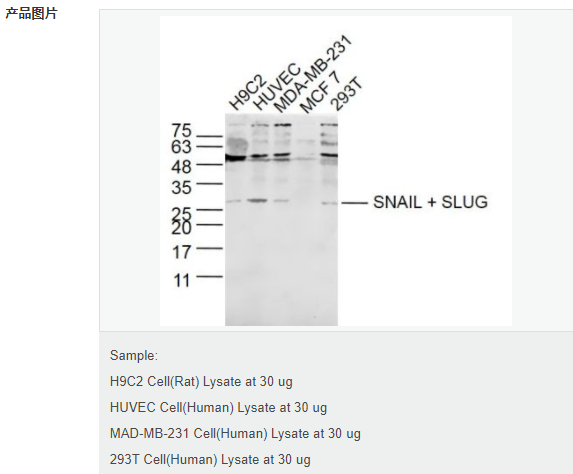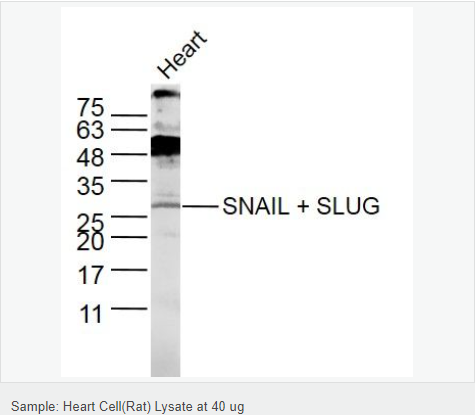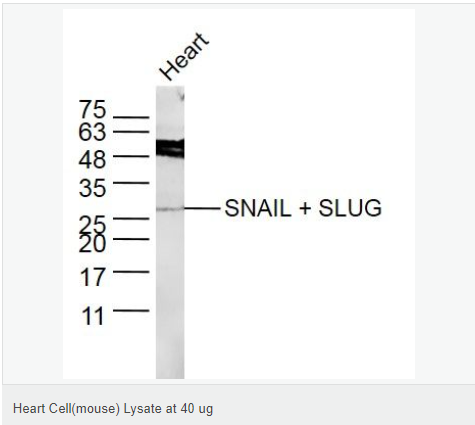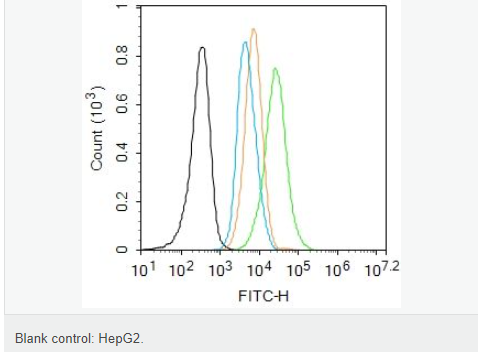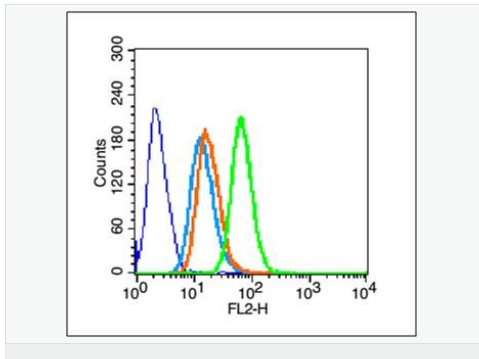
货号
产品规格
售价
备注
BN40338R-100ul
100ul
¥2360.00
交叉反应:Human,Mouse,Rat(predicted:Chicken,Dog,Pig,Cow,Rabbit,Sheep,GuineaPig,Danio rerio) 推荐应用:WB,IHC-P,IHC-F,IF,Flow-Cyt,ELISA
BN40338R-200ul
200ul
¥3490.00
交叉反应:Human,Mouse,Rat(predicted:Chicken,Dog,Pig,Cow,Rabbit,Sheep,GuineaPig,Danio rerio) 推荐应用:WB,IHC-P,IHC-F,IF,Flow-Cyt,ELISA
| 英文名称 | SNAIL + SLUG |
| 中文名称 | 锌指转录因子Slug+SNAIL抗体 |
| 别 名 | SNAIL+SLUG; dJ710H13.1; Protein sna; Protein snail homolog; SLUGH2; SNA; Sna protein; SNAH; SNAI1; Snail homolog 1 (Drosophila); Zinc finger protein SNAI1; SNAI1_HUMAN; Protein snail homolog 1; dJ710H13.1; SNAIL; SNAIL1; Protein sna; Neural crest transcription factor Slug; Protein snail homolog 2; Slug (chicken homolog) zinc finger protein; Slug homolog zinc finger protein; Slug zinc finger protein; SLUGH 1; SLUGH; SLUGH1; SNAI 2; SNAI2; SNAI-2; SNAI2_HUMAN; Snail 2; Snail homolog 2; Snail2; Snail-2; WS 2D; WS2D; Zinc finger protein SLUG; Zinc finger protein SNAI2. |
| 研究领域 | 肿瘤 细胞生物 免疫学 神经生物学 信号转导 干细胞 转录调节因子 表观遗传学 |
| 抗体来源 | Rabbit |
| 克隆类型 | Polyclonal |
| 交叉反应 | Human, Mouse, Rat, (predicted: Chicken, Dog, Pig, Cow, Rabbit, Sheep, Guinea Pig, Danio rerio) |
| 产品应用 | WB=1:500-2000 ELISA=1:5000-10000 IHC-P=1:100-500 IHC-F=1:100-500 Flow-Cyt=1μg/Test ICC=1:100-500 IF=1:100-500 (石蜡切片需做抗原修复) not yet tested in other applications. optimal dilutions/concentrations should be determined by the end user. |
| 分 子 量 | 30kDa |
| 细胞定位 | 细胞核 细胞浆 |
| 性 状 | Liquid |
| 浓 度 | 1mg/ml |
| 免 疫 原 | KLH conjugated synthetic peptide derived from human SNAIL + SLUG:151-250/264 |
| 亚 型 | IgG |
| 纯化方法 | affinity purified by Protein A |
| 储 存 液 | 0.01M TBS(pH7.4) with 1% BSA, 0.03% Proclin300 and 50% Glycerol. |
| 保存条件 | Shipped at 4℃. Store at -20 °C for one year. Avoid repeated freeze/thaw cycles. |
| PubMed | PubMed |
| 产品介绍 | SNAIL: The Drosophila embryonic protein snail is a zinc finger transcriptional repressor which downregulates the expression of ectodermal genes within the mesoderm. The nuclear protein encoded by this gene is structurally similar to the Drosophila snail protein, and is also thought to be critical for mesoderm formation in the developing embryo. At least two variants of a similar processed pseudogene have been found on chromosome 2. [provided by RefSeq, Jul 2008]. SLUG: This gene encodes a member of the Snail family of C2H2-type zinc finger transcription factors. The encoded protein acts as a transcriptional repressor that binds to E-box motifs and is also likely to repress E-cadherin transcription in breast carcinoma. This protein is involved in epithelial-mesenchymal transitions and has antiapoptotic activity. Mutations in this gene may be associated with sporatic cases of neural tube defects. [provided by RefSeq, Jul 2008]. Function: Involved in the epithelial to mesenchymal transition (EMT) and formation and maintenance of embryonic mesoderm. Binds to 3 E-boxes of the E-cadherin gene promoter and represses its transcription. Subunit: Interacts with FBXL14 and GSK3B. Interacts with BTRC; interaction occurs when it is phosphorylated on the destruction motif. Interacts (via SNAG domain) with WTIP (via LIM domains). Interacts (via SNAG domain) with LIMD1 (via LIM domains), and AJUBA (via LIM domains). Interacts with LOXL2 and LOXL3. Subcellular Location: Nucleus. Cytoplasm. Note=Once phosphorylated (probably on Ser-107, Ser-111, Ser-115 and Ser-119) it is exported from the nucleus to the cytoplasm where subsequent phosphorylation of the destruction motif and ubiquitination involving BTRC occurs. Tissue Specificity: Expressed in a variety of tissues with the highest expression in kidney. Expressed in mesenchymal and epithelial cell lines. Post-translational modifications: Phosphorylated by GSK3B. Once phosphorylated, it becomes a target for BTRC ubiquitination. Ubiquitinated on Lys-98, Lys-137 and Lys-146 by FBXL14 and BTRC leading to degradation. BTRC-triggered ubiquitination requires previous GSK3B-mediated SNAI1 phosphorylation. O-GlcNAcylation at Ser-112 is enhanced in hyperglycaemic conditions, it opposes phosphorylation by GSK3B, and stabilizes the protein. Similarity: Belongs to the snail C2H2-type zinc-finger protein family. Contains 4 C2H2-type zinc fingers. SWISS: O43623 Gene ID: 6615 Database links: Entrez Gene: 6591 Human Entrez Gene: 6615 Human Entrez Gene: 20583 Mouse Entrez Gene: 20613 Mouse Omim: 604238 Human SwissProt: O43623 Human SwissProt: O95863 Human SwissProt: P97469 Mouse SwissProt: Q02085 Mouse Unigene: 360174 Human Unigene: 48029 Human Unigene: 2093 Mouse Unigene: 4272 Mouse Important Note: This product as supplied is intended for research use only, not for use in human, therapeutic or diagnostic applications. |
